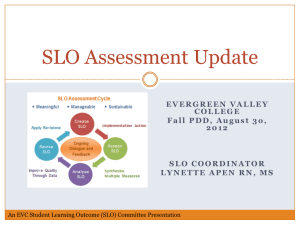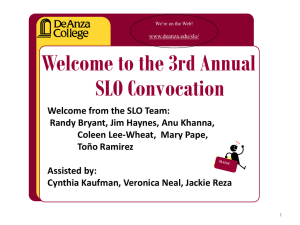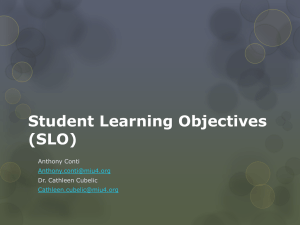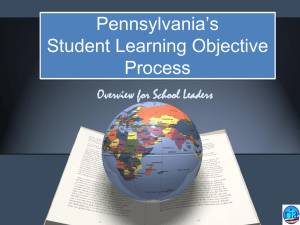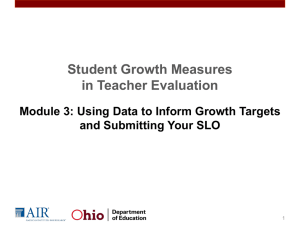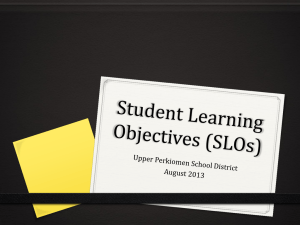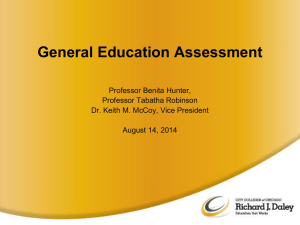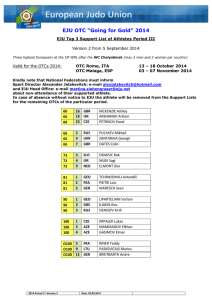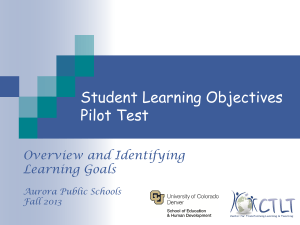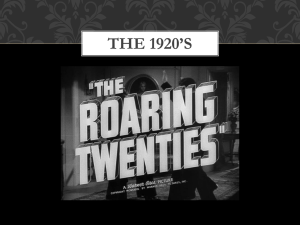PA Student Learning Objectives (SLOs)Process for Administrators
advertisement
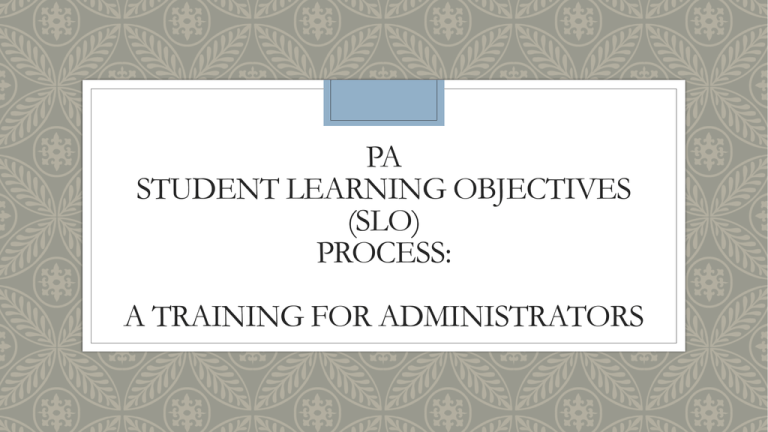
PA STUDENT LEARNING OBJECTIVES (SLO) PROCESS: A TRAINING FOR ADMINISTRATORS Goals and Objectives ◦ Goal: ◦ Provide school leaders guidance and procedural suggestions for the implementation of student learning objectives (SLOs) as part of PDE’s Educator Effectiveness System. ◦ Objectives: 1.Orient school leaders to PDE’s SLO process. 2.Identify roles and responsibilities needed to implement SLOs. 3.Review tasks and review suggested procedures for each phase (Design, Build, & Review). Pie Chart w/PVAAS 3 4 PDE Teacher Effectiveness Final Rating Form ◦ How will I calculate my final Teacher Effectiveness Rating? How will SLOs affect my final rating score? ◦ Use the Excel tool on the PDE website at: ◦ http://www.portal.state.pa.us/portal/server.pt/community/educato r_effectiveness_project/20903 Student Learning Objectives (SLOs) Orientation SLO Definition ◦ A process to document a measure of educator effectiveness based on student achievement of content standards. SLOs are a part of Pennsylvania’s multiplemeasure, comprehensive system of Educator Effectiveness authorized by Act 82 (HB 1901). Every teacher designs an SLO Math History Physics Physical Education Chemistry Kindergarten Special Ed Journalism 14 Should You Write an SLO? The SLO in PA is written to a specific teacher and a specific class/course/content area for which that teacher provides instruction. To determine whether you are a teaching professional, you must be able to answer yes to the following two questions: 1. Are you working under your instructional certification? 2. Do you provide direct instruction to students in a particular subject? Working Together to Create an SLO ◦ Collaborative development of an SLO is encouraged (e.g., similar content area or grade level teachers, interdisciplinary groups of educators) ◦ Caution: All educators must have their own copy of the SLO. Educators must measure the performance indicators against only the students assigned to them. Check for understanding…. Time for Table Talk about: How is the SLO used? Who writes an SLO? What does an SLO measure? SLO Template 10.0 ◦ A tool used to identify goals, indicators, and performance measures for use in the greater Teacher Effectiveness System ◦ Must use this template unless your submit your own tool for approval through PDE What is a Performance Measure? ◦ The assessment ◦ Name ◦ Purpose ◦ Type ◦ Metric ◦ Administration ◦ Scoring details ◦ reporting SLO Process Components The SLO process contains three (3) action components: 1. Design (ing): thinking, conceptualizing, organizing, discussing, researching 2. Build (ing): selecting, developing, sharing, completing 3. Review (ing): refining, checking, updating, editing, testing, finalizing SLO Template Steps: Teacher 1.ClassroomContext 1a.Name 1b.School 1c.District 1d.Class/ CourseTitle 1e.Grade Level 1f.Total#of Students 1g.Typical ClassSize 1h.Class Frequency 1i.Typical ClassDuration 2.SLOGoal 2a.GoalStatement 2b.PAStandards 2c.Rationale Section 1: Classroom Context ◦ General Description •Contains demographic information about the educational setting •Articulates the course, grade(s), and students the SLO is based on •Provides class size, frequency, and duration data Section 2: Goal Statement ◦ What is a goal statement? ◦ Narrative articulating the “big idea” upon which the SLO is based ◦ Central to the content area ◦ Foundational concept for later subjects/courses ◦ Typically addresses what, how and why ◦ This section also includes PA standards associated with the goal and articulates a rationale for the Goal Statement 17 Big Idea In Pennsylvania, there is a location that we find our “big ideas” for curriculum www.pdesas.org • Curriculum Frameworks Tab • At bottom of the page • Select a subject area • Select grade level SLO Template Steps: Teacher 3.PerformanceIndicators(PI) 3a.PITargets: AllStudentGroup PITarget#1 PITarget#2 PITarget#3 PITarget#4 PITarget#5 3b.PITargets: SubsetStudentGroup (optional) PITarget#1 PITarget#2 PITarget#3 PITarget#4 PITarget#5 3c.PILinked (optional) 3d.PIWeighting (optional) What is a Performance Indicator? ◦ The performance indicator articulates targets for Performance Measure ◦ A PI describes an individual student performance expectation ◦ This section may include a focused student group (Optional) ◦ Affords teachers the opportunity to link and/or weigh indicators (Optional) SLOTemplateSteps: Teacher 4.PerformanceMeasures(PM) 4a.Name PM#1 PM#2 PM#3 PM#4 PM#5 4c. Purpose PM#1 PM#2 PM#3 PM#4 PM#5 4e. Administration Frequency PM#1 PM#2 PM#3 PM#4 PM#5 4g.Resources/ Equipment PM#1 PM#2 PM#3 PM#4 PM#5 4i. Administration & ScoringPersonn el PM#1 PM#2 PM#3 PM#4 PM#5 4b.Type ____District-designedMeasuresand Examinations ____NationallyRecognizedStandardizedTests ____IndustryCertificationExaminations ____StudentProjects ____StudentPortfolios ____Other:______________________________ 4d.Metric Growth(changeinstudentperformanceacross twoormorepointsintime) Mastery(attainmentofadefinedlevelof achievement) GrowthandMastery 4f.Adaptations/ Accommodation s IEP ELL 4h.ScoringTools PM#1 PM#2 PM#3 PM#4 PM#5 4j.Performance Reporting PM#1 PM#2 PM#3 PM#4 PM#5 GiftedIEP Other What is a Performance Measure? ◦ Identifies all performance measures, including name, purpose, type, and metric ◦ Articulates the administration and scoring details, including the reporting ◦ PMs must be aligned to targeted content standards ◦ Consider what assessments you are currently using in your classroom and if they will work in your SLO….also consider if you will need to design a new assessment… SLO Process Design Example Goals/ Standards Performance Indicator Performance Measures Assessment #1a Indicator #1 SLO Goal Indicator #2 Assessment #1b Assessment #2 SLO Template Steps: Teacher 5.TeacherExpectations 5a.Level Failing 0%to___%of studentswillmeetthe PItargets. NeedsImprovement ___%to___%of studentswillmeetthe PItargets. Proficient ___%to___%of studentswillmeetthePI targets. Distinguished ___%to100%of studentswillmeetthePI targets. Teacher Signature _________________________Date______ Evaluator Signature _____________________Date______ Notes/Explanation Distinguished (3) 5b. Elective Rating Proficient (2) Needs Improvement (1) Failing (0) . Teacher Signature _________________________Date______ Evaluator Signature _____________________Date______ Teacher Expectations This section selects the overall SLO rating for the teacher…. Below is an example only: these scores should reflect a collaboration between the teacher and the administrator. ◦ Failing: 0% - 69% ◦ Needs Improvement: 70% - 84% ◦ Proficient: 85% - 94% ◦ Distinguished: 95% - 100% How do I total a teacher’s final score? Check for learning…. Time for Table Talk about: In what ways do the elements of the SLO Template interact with each other?? What questions, if any, do you have regarding the components of the SLO process and template? Key Points for School Leaders ◦The SLO Process facilitates a conversation about expectation between educators (principals and teachers) School Leader Roles and Responsibilities: Establish a Timeline Example of a SLO Timeframe: Typical School Year ◦ July through September – Teachers Design, Build, and Review the SLO; meet to review the SLO and sign ◦ October through February – Teachers Implement the SLO; meet mid-year to touch base ◦ March through June – Principal and Teacher Review Performance; teachers brings data to end-of-year meeting Generic Process Steps for a School Leader 1. Establish SLO template completion timeline at beginning of year 2. Review complete template 3. Conduct review meeting with teacher 4. Agree on any revisions; submit materials 5. Establish “mid-cycle” spot review 6. End-of-Year review with supporting data SLO Phases - Roles and Responsibilities ◦ DESIGN Roles & Responsibilities ◦ Educators: Designers that identify content standards and students ◦ Leaders: Facilitators that identify schoolwide needs and timeline for submission ◦ BUILD Roles & Responsibilities ◦ Educators: Developers that identify performance measures and expectations within the SLO Process Template ◦ Leaders: Coaches that clarify and guide SLO template completion ◦ REVIEW Roles & Responsibilities ◦ Educators: Checkers that verify the SLO is complete and comprehensive ◦ Leaders: Reviewers that validate expectations and ensure coherency Design: School Leader Tasks 1.Establish timeline and expectations for SLOs 2.Identify SLO training and other resources 3.Identify any school-wide needs that can be supported by the SLO process 4.Promulgate achievement data from prior year(s) Building: School Leader Tasks 1.Clarify expectations for SLOs 2.Provide additional SLO training and other resources 3.Screen draft material prior to conferencing with educator 4.Designate school-based, subject matter expert (SMEs) to support development 5.Coordinate district and IU professional development assets Review: School Leader Tasks 1. Conduct preliminary review (screen) proposed SLO 2. Implement conference with educator: a)Develop “triage” from screening materials b)Align time allocation given preliminary review c)Provide “key points of discussion” prior to conference 3. Discuss proposed SLO and applicable performance measures 4. Identify any corrections, refinements, etc. 5. Sign form and establish follow-up timeline Procedural Conference ◦ The SLO process facilitates a conversation about expectation between educators and school leaders Procedural Discussion Points: Fall ◦ Goals - Standards ◦ Measures What is the subject/content focus? Why are they considered high quality measures? Who does it encompass? How can it improve instruction/practice? ◦ Indicators What are indicators of success? How are they being measured? Which students are they based upon? Who administers and scores the measures? What types of data are produced? Procedural Discussion Points: Winter ◦ Goals and Standards ◦ Measures •How has the instruction supported the subject/content focus? •Which measures have been administered so far? •Which student groups are making progress or struggling? •What are the data telling us about student growth and/or mastery? •What instruction/practice adaptations will be need in the spring? ◦ Indicators • Are indicators of success still applicable? • How well are the indicators working? • Which indicators are producing data about student performance? •Are additional measures necessary at this time? Procedural Discussion Points: Springo Goals and Standards • To what degree was the “big idea” mastered by students? • Which content standards will need additional instruction? • How can the standards be taught more effectively? o Indicators • Which indicators were established too high or too low? • What did the indicators tell you about student performances? • Which student groups underperformed on selected indicators? o Measures •Which measures should be discontinued or need significant revisions? •To what degree did student performances meet your expectations? •What data points had the most influence on your overall rating? Procedural Areas of Caution 1.The SLO is based upon small numbers of students/data points. 2.Goals and indicators are “loosely” linked to targeted standards. 3.Indicators are vague without specific performance criteria. 4.Growth and/or mastery is not clearly defined. 5.Performance measures are poorly designed, lack rigor, and/or not designed to measure PA standards. 6.Overall achievement expectations are unattainable SLO Process Online Available Templates Available Rubrics My History Resources Research In Action SLO Online Resources SAS is the PDE website containing… • the Pennsylvania content standards and other helpful PDE developed material • a downloadable SLO training “packet”, including SLO Models • links to Research in Action’s training platform, Homeroom • Learning Communities: SAS Institute 2013 and SLO communities Homeroom is RIA’s web-based learning platform that contains… • on-line training materials, including the SLO Process Template 10.0 • downloadable SLO training files, except the videos • links to SAS portal SLO Resources in Your Folders ◦ SLO Template 10.0 ◦ SLO Help Desk reference ◦ SLO Final Scoring Samples ◦ School Leader Discussion Questions: SLO Considerations for Principals and School Leaders ◦ School Leader SLO Checklist ◦ SLO Quick Start Guide for School Leaders ◦ Guiding Questions for School Leader Discussions to ask regarding the SLO to Push Toward Distinguished ◦ ****SLO Narrated PowerPoint Overview Resources School Leader Discussion Questions… ◦ In a small group, discuss the questions listed on the SLO Considerations for Principals and School Leaders: School Leader Discussion Questions in your folder. Be prepared to share your small group discussions with the entire group! Table Talk: Share thoughts about this process and discuss any questions you may still have… For additional SLO questions, please contact: Local IU1 Contacts State Contacts ◦ JoBeth McKee – IU1 Curriculum Specialist, jobeth.mckee@iu1.org, 724-938-3241 ext. 267 ◦ Mr. David Deitz, PDE POC, oddeitz@comcast.net ◦ Jenny Lent – IU1 Curriculum Specialist, jenny.lent@iu1.org, 724-938-3241 ext. 268 ◦ Dr. JP Beaudoin, The RIA Group POC, jbeaudoin@riagroup2013.com ◦ Marissa Sacco – IU1 TAC (Literacy and Inclusive Practices), marissa.sacco@iu1.org, 724-938-3241 ext. 713 ◦ Wendy Tiano – IU1 TAC (Reading and RtII), wendy.tiano@iu1.org, 724-938-3241 ext. 717

